 According to the tradition, the frazione of Governolo was the seat of the meeting between Pope Leo I
According to the tradition, the frazione of Governolo was the seat of the meeting between Pope Leo I and Attila in 452. Also in Governolo the condottiero Giovanni dalle Bande Nere
and Attila in 452. Also in Governolo the condottiero Giovanni dalle Bande Nere  was shot by a
was shot by a 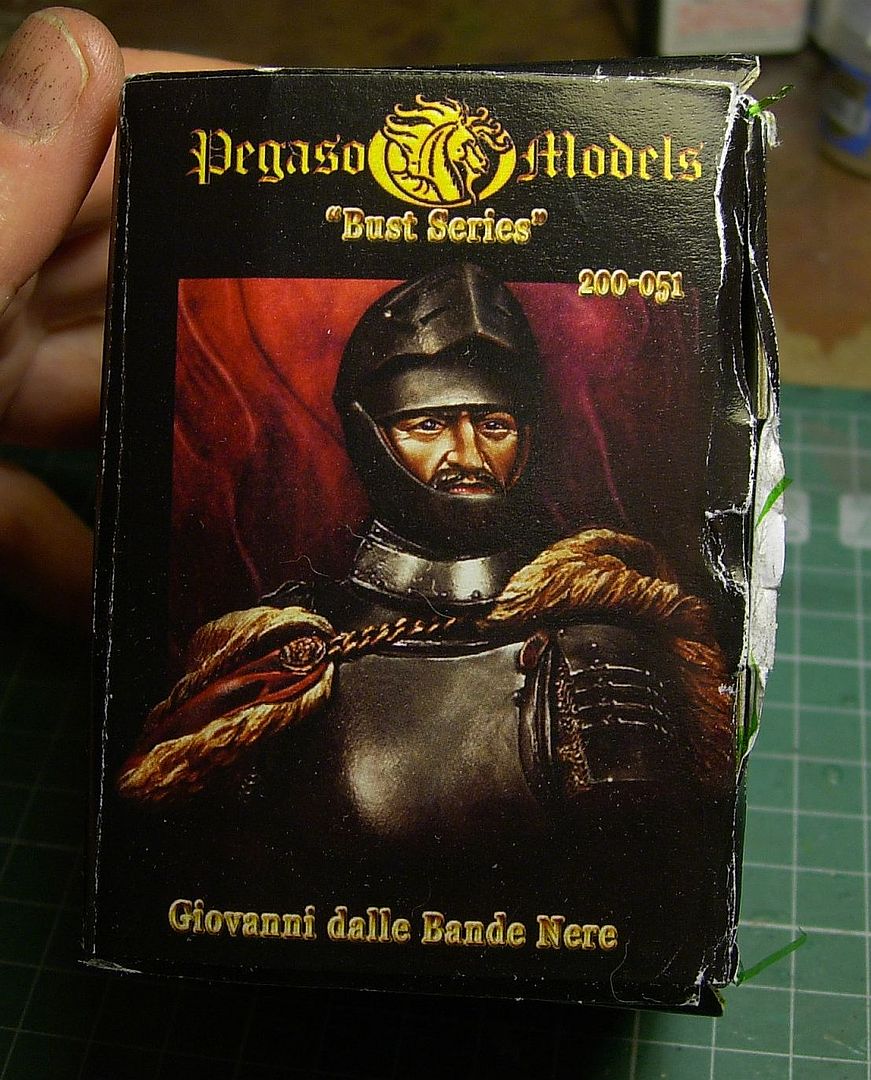 cannonball in 1526, later dying out of the wounds received.Giovanni was born in the Northern Italian town of Forlì
cannonball in 1526, later dying out of the wounds received.Giovanni was born in the Northern Italian town of Forlì to Giovanni de' Medici (also known as il Popolano) and Caterina Sforza,
to Giovanni de' Medici (also known as il Popolano) and Caterina Sforza, one of the most famous women of the Italian Renaissance.
one of the most famous women of the Italian Renaissance.
From an early age, he demonstrated great interest and ability in physical activity, especially the martial arts of the age: horse riding, sword-fighting, etc. He committed his first murder at the age of 12, and was twice banished from the city of Florence for his unruly  behavior, including involvement in the rape of a sixteen-year-old boy, Giovanni being about thirteen at the time.He had a son,Cosimo
behavior, including involvement in the rape of a sixteen-year-old boy, Giovanni being about thirteen at the time.He had a son,Cosimo (1519–1574), who went on to become Grand Duke of Florence.
(1519–1574), who went on to become Grand Duke of Florence.
 behavior, including involvement in the rape of a sixteen-year-old boy, Giovanni being about thirteen at the time.He had a son,Cosimo
behavior, including involvement in the rape of a sixteen-year-old boy, Giovanni being about thirteen at the time.He had a son,Cosimo (1519–1574), who went on to become Grand Duke of Florence.
(1519–1574), who went on to become Grand Duke of Florence.
As a symbol of mourning for the death of Pope Leo X (December 1, 1521), Giovanni added black 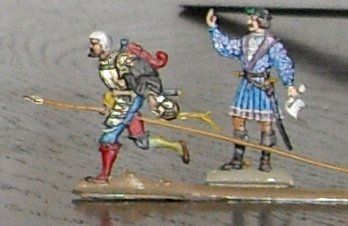 stripes to his insignia, whence comes his nickname, Giovanni dalle Bande Nere (or Giovanni of the
stripes to his insignia, whence comes his nickname, Giovanni dalle Bande Nere (or Giovanni of the  Black Bands). In August 1523 he was hired by the Imperial army, and in January 1524 he defeated the French and the Swiss at Caprino Bergamasco.
Black Bands). In August 1523 he was hired by the Imperial army, and in January 1524 he defeated the French and the Swiss at Caprino Bergamasco. In the same year another Medici, Giulio di Giuliano, became Pope, and took the name of Clement VII. The new Pope paid all of Giovanni's debt, but in exchange ordered him to switch to the French side of
In the same year another Medici, Giulio di Giuliano, became Pope, and took the name of Clement VII. The new Pope paid all of Giovanni's debt, but in exchange ordered him to switch to the French side of 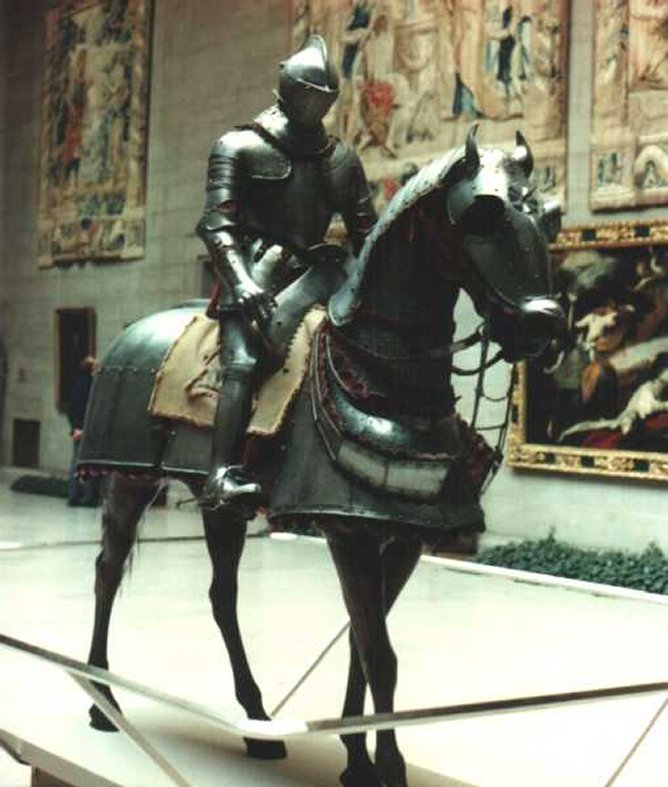 the ongoing conflict. He did not take part in the battle of Pavia, but was soon severely wounded in a skirmish and later had to move toVenice to recuperate from his wounds.Giovanni became
the ongoing conflict. He did not take part in the battle of Pavia, but was soon severely wounded in a skirmish and later had to move toVenice to recuperate from his wounds.Giovanni became  a condottiero, or mercenary military captain, in the employ of Pope Leo X(Giovanni di Lorenzo de' Medici) and on March 5, 1516 led the war against Francesco Maria I della Rovere, Duke of Urbino. He
a condottiero, or mercenary military captain, in the employ of Pope Leo X(Giovanni di Lorenzo de' Medici) and on March 5, 1516 led the war against Francesco Maria I della Rovere, Duke of Urbino. He  thenceforth formed a company of his own, mounted on light horses and specializing in fast but devastating skirmishing tactics and ambushes. In 1520 he defeated several rebel barons in
thenceforth formed a company of his own, mounted on light horses and specializing in fast but devastating skirmishing tactics and ambushes. In 1520 he defeated several rebel barons in 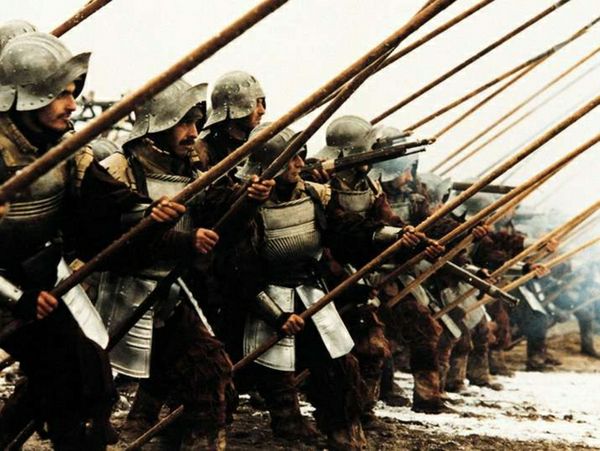 the Marche. The following year Leo X allied with Emperor Charles V against King Francis I of France
the Marche. The following year Leo X allied with Emperor Charles V against King Francis I of France
to regain Milan, Parma and Piacenza; Giovanni was called in under the command of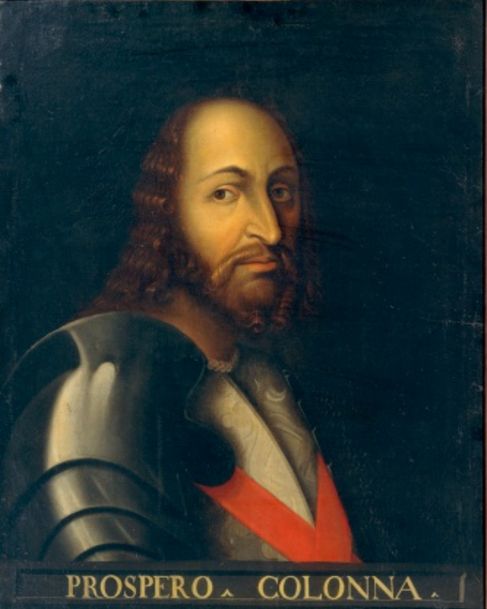 Prospero Colonna, defeating the French at Vaprio d'Adda in November.
Prospero Colonna, defeating the French at Vaprio d'Adda in November.
 stripes to his insignia, whence comes his nickname, Giovanni dalle Bande Nere (or Giovanni of the
stripes to his insignia, whence comes his nickname, Giovanni dalle Bande Nere (or Giovanni of the  Black Bands). In August 1523 he was hired by the Imperial army, and in January 1524 he defeated the French and the Swiss at Caprino Bergamasco.
Black Bands). In August 1523 he was hired by the Imperial army, and in January 1524 he defeated the French and the Swiss at Caprino Bergamasco. In the same year another Medici, Giulio di Giuliano, became Pope, and took the name of Clement VII. The new Pope paid all of Giovanni's debt, but in exchange ordered him to switch to the French side of
In the same year another Medici, Giulio di Giuliano, became Pope, and took the name of Clement VII. The new Pope paid all of Giovanni's debt, but in exchange ordered him to switch to the French side of  the ongoing conflict. He did not take part in the battle of Pavia, but was soon severely wounded in a skirmish and later had to move toVenice to recuperate from his wounds.Giovanni became
the ongoing conflict. He did not take part in the battle of Pavia, but was soon severely wounded in a skirmish and later had to move toVenice to recuperate from his wounds.Giovanni became  a condottiero, or mercenary military captain, in the employ of Pope Leo X(Giovanni di Lorenzo de' Medici) and on March 5, 1516 led the war against Francesco Maria I della Rovere, Duke of Urbino. He
a condottiero, or mercenary military captain, in the employ of Pope Leo X(Giovanni di Lorenzo de' Medici) and on March 5, 1516 led the war against Francesco Maria I della Rovere, Duke of Urbino. He  thenceforth formed a company of his own, mounted on light horses and specializing in fast but devastating skirmishing tactics and ambushes. In 1520 he defeated several rebel barons in
thenceforth formed a company of his own, mounted on light horses and specializing in fast but devastating skirmishing tactics and ambushes. In 1520 he defeated several rebel barons in  the Marche. The following year Leo X allied with Emperor Charles V against King Francis I of France
the Marche. The following year Leo X allied with Emperor Charles V against King Francis I of France
to regain Milan, Parma and Piacenza; Giovanni was called in under the command of
 Prospero Colonna, defeating the French at Vaprio d'Adda in November.
Prospero Colonna, defeating the French at Vaprio d'Adda in November.
In 1526 the War of the League of Cognac broke out. The League's captain general, Francesco Maria I della Rovere, abandoned Milan in the face of the
The League's captain general, Francesco Maria I della Rovere, abandoned Milan in the face of the 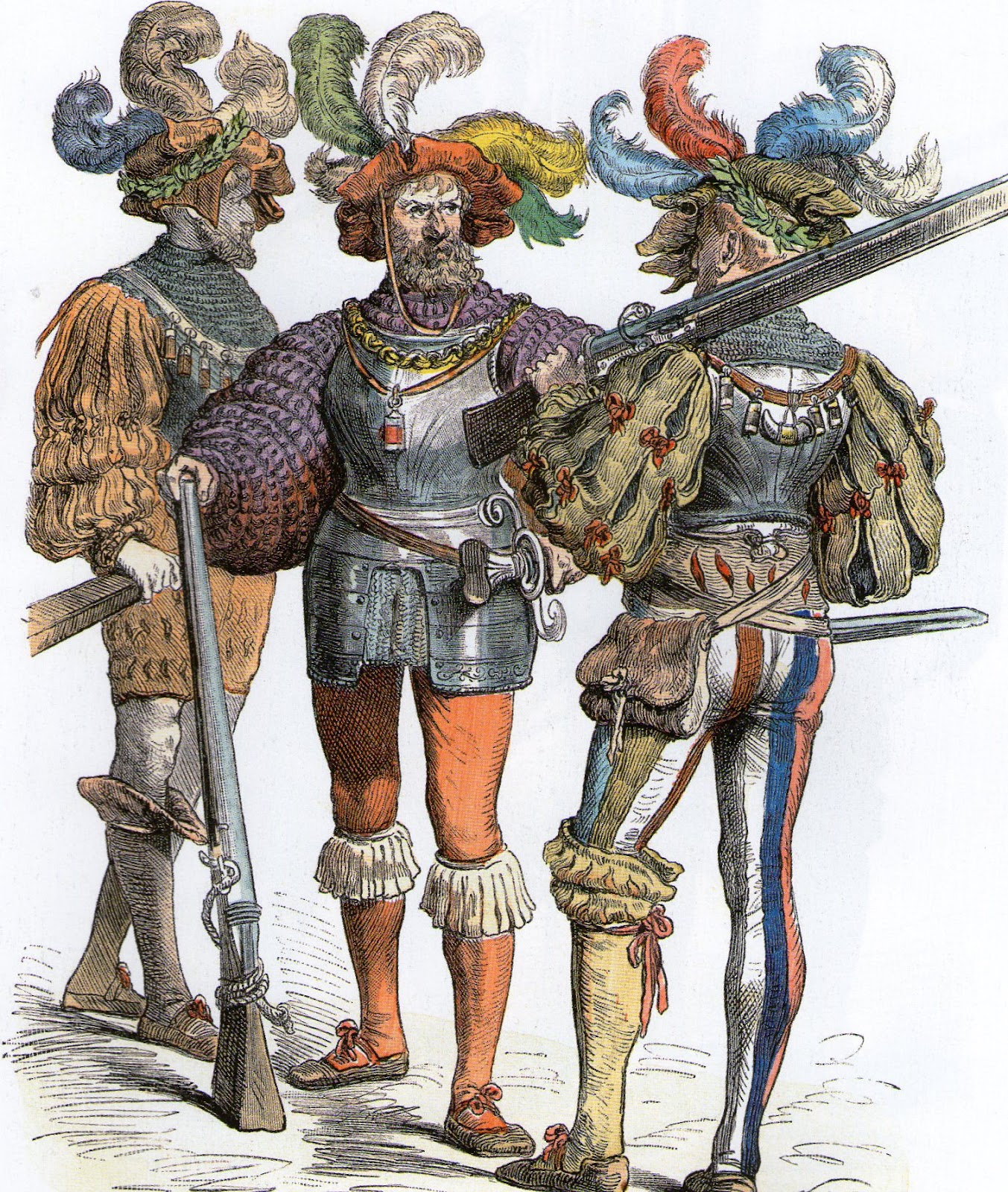 overwhelming superiority of the Imperial army led by Georg von Frundsberg. Giovanni was able to defeat theLandsknechts
overwhelming superiority of the Imperial army led by Georg von Frundsberg. Giovanni was able to defeat theLandsknechts rearguard at the confluence of the Mincio with the Po River.
rearguard at the confluence of the Mincio with the Po River.
 The League's captain general, Francesco Maria I della Rovere, abandoned Milan in the face of the
The League's captain general, Francesco Maria I della Rovere, abandoned Milan in the face of the  overwhelming superiority of the Imperial army led by Georg von Frundsberg. Giovanni was able to defeat theLandsknechts
overwhelming superiority of the Imperial army led by Georg von Frundsberg. Giovanni was able to defeat theLandsknechts rearguard at the confluence of the Mincio with the Po River.
rearguard at the confluence of the Mincio with the Po River.
On the evening of November 25 he was hit by a shot from a falconet in a battle near Governolo
in a battle near Governolo .According to a contemporary account by Luigi Guicciardini, the ball shattered his right leg above the knee and he had to be carried to San Nicolò Po, near Bagnolo
.According to a contemporary account by Luigi Guicciardini, the ball shattered his right leg above the knee and he had to be carried to San Nicolò Po, near Bagnolo  San Vito, where no doctor could be found. He was taken to Aloisio Gonzaga's palace, marquis of Castel Goffredo, in Mantua, where the surgeon Abramo,
San Vito, where no doctor could be found. He was taken to Aloisio Gonzaga's palace, marquis of Castel Goffredo, in Mantua, where the surgeon Abramo, who had cared for him two years
who had cared for him two years  earlier, amputated his leg. To perform the operation Abramo asked for 10 men to hold down the stricken condottiero.
earlier, amputated his leg. To perform the operation Abramo asked for 10 men to hold down the stricken condottiero.
Pietro Aretino, eyewitness to the event, recalled in a letter to Francesco Albizi:
Despite the surgery Giovanni de' Medici died five days later, supposedly of septicemia, on 30 November 1526.

Giovanni's body was exhumed in 2012 along with that of his wife to preserve the remains,  which were damaged in the 1966 flood of the Arno river, and to ascertain the cause of his death.
which were damaged in the 1966 flood of the Arno river, and to ascertain the cause of his death.
 which were damaged in the 1966 flood of the Arno river, and to ascertain the cause of his death.
which were damaged in the 1966 flood of the Arno river, and to ascertain the cause of his death.
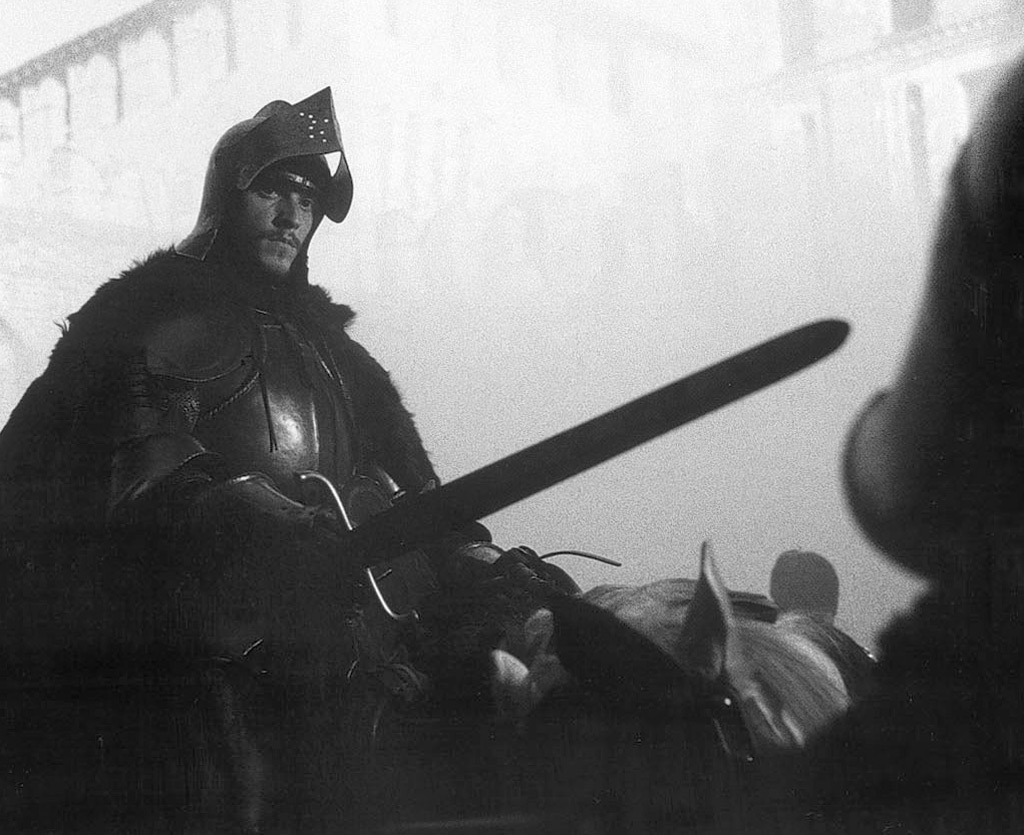 Preliminary investigation revealed that his leg was amputated below the knee. No damage was found to the thigh, where the shot supposedly hit. The tibia and fibula, the bones of the lower leg, were found sawed off from the amputation. There was no damage to the femur.
Preliminary investigation revealed that his leg was amputated below the knee. No damage was found to the thigh, where the shot supposedly hit. The tibia and fibula, the bones of the lower leg, were found sawed off from the amputation. There was no damage to the femur.
It is now thought that de' Medici may have died of gangrene.
Giovanni's premature death metaphorically signaled the end of the age of the condottieri, as their mode of fighting (which emphasized armored knights on horseback) was rendered practically obsolete by the introduction of the mobile field cannon. He is therefore known as the last of the great
their mode of fighting (which emphasized armored knights on horseback) was rendered practically obsolete by the introduction of the mobile field cannon. He is therefore known as the last of the great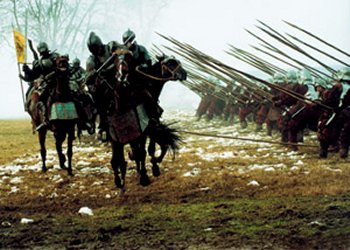 Italian condottieri. His lasting reputation has been kept alive in part thanks to Pietro Aretino,
Italian condottieri. His lasting reputation has been kept alive in part thanks to Pietro Aretino, the Renaissance author, satirist, playwright and "scourge of the
the Renaissance author, satirist, playwright and "scourge of the princes", who was Giovanni's close friend and accompanied him on some of his exploits.
princes", who was Giovanni's close friend and accompanied him on some of his exploits.
 Italian condottieri. His lasting reputation has been kept alive in part thanks to Pietro Aretino,
Italian condottieri. His lasting reputation has been kept alive in part thanks to Pietro Aretino, princes", who was Giovanni's close friend and accompanied him on some of his exploits.
princes", who was Giovanni's close friend and accompanied him on some of his exploits.
A noble-but-brutal Renaissance warrior who fell to a battle wound may not have died exactly as historians had believed, according to a new investigation of the man's bones.
Italian researchers opened the tomb of Giovanni dalle Bande Nere, or Giovanni of the Black Bands, this week to investigate the real cause of his death. Giovanni was born in 1498 into the wealthy and influential Medici family, a lineage that produced three Popes and two regent queens of France, among many other nobles (Another branch of the family, the Medicis of Milan, boasted a fourth Pope). He worked as a mercenary military captain for Pope Leo X (one of the Medici family's Popes), 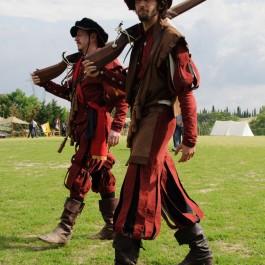 and fought many a successful skirmish in his name. When Pope Leo X died in 1521, Giovanni altered his uniform to include black mourning bands, earning him his nickname
and fought many a successful skirmish in his name. When Pope Leo X died in 1521, Giovanni altered his uniform to include black mourning bands, earning him his nickname .
.
 and fought many a successful skirmish in his name. When Pope Leo X died in 1521, Giovanni altered his uniform to include black mourning bands, earning him his nickname
and fought many a successful skirmish in his name. When Pope Leo X died in 1521, Giovanni altered his uniform to include black mourning bands, earning him his nickname .
.
Giovanni was wounded in battle in 1526; reportedly, his leg was amputated and he died several days later of infection. However, the new investigation of the Giovanni remains reveals that it was not his leg that was sawn off, but his foot. Nor is there any damage to the man's thigh, where the shot supposedly hit.Archaeologists open the tomb of Giovanni dalle Bande Nere in Florence.
Giovanni's grave has been opened five times already, including an investigation in 1945. This confirmation of the man's actual wound has created a medical mystery.
"Giovanni was wounded in the right leg (maybe above the knee) but was amputee[d] [at the] foot," Marco Ferri, a spokesman for the Superintendent of Fine Arts of Florentine Museums, wrote in an email to LiveScience. "Why? The surgeon was not a good doctor or the news [that] reached us [is] not accurate."
Giovanni's bones rest with those of his wife, Maria Salviati in two zinc boxes in the crypt of the Medici Chapels in Florence. The man's tibia and fibula, the bones of the lower leg, were found sawed off from the amputation. There was no damage to the femur (thigh bone).
Ferri said the team would further measure and analyze the bones before reburying them. The findings are preliminary and have yet to be published in a peer-reviewed journal.Preliminary measurements suggest that Giovanni was about 5 feet, 10 inches tall (178 centimeters). Researchers, led by paleopathologist Gino Fornaciari of the University of Pisa, also found a tubelike glass container with a rolled-up card inside that may bear an inscription. This container was not mentioned in reports of earlier investigations of the crypt.
No comments:
Post a Comment